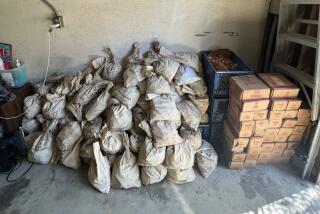Hard Times for the Feuchtwanger Cent
- Share via
Question: I have just recently started collecting coins. Most of my older coins have been given to me by my grandfather from his collection. He has just given me an odd-looking coin and he doesn’t remember its origin.
I think it’s foreign; he claims it is definitely American. It is in very fine condition, not worn much at all.
It has a profile of a flying eagle with a snake in its claws and the date 1837 below that. On the reverse it has the word Feuchtwanger’s around the top and Composition around the bottom with the phrase one cent printed in the middle.
Please tell me any interesting history about it, what it might be made of and how much it might be worth.--J.S.
Answer: Your grandfather has given you a very interesting piece. Technically, it’s not a coin at all. It’s known as a Feuchtwanger Cent, and it falls into the category of “hard-times tokens.” These were patterned after the United States large cents and were privately made during the 1830s and 1840s. Many were political in nature, had no real monetary value, did not circulate widely and went out of circulation when economic conditions improved.
What set the Feuchtwanger Cent apart is that its designer, Lewis Feuchtwanger, used a metal known as German silver, consisting of nickel, copper and zinc. Feuchtwanger urged Congress to use this in place of copper coinage but the idea was rejected. Feuchtwanger came to the United States from Germany. He was a scientist who didn’t dwell on the congressional turndown, although German silver is still in use.
Your Feuchtwanger Cent might lead you into all sorts of collecting, including hard-times tokens, patterns, early coinage and other bits of Americana. Your coin is probably worth between $20 and $50, but because it was a gift from your grandfather, I think it’s priceless.
Q: I have a coin that is a puzzle not only to me but to other collectors. Enclosed are two pictures. It’s a little bigger than the Ike dollar. Can you tell me the type of coin? Where from? And the value?--A.C.
A: Your coin is a restrike of the Maria Teressa taler. It’s a silver piece from Austria but has actually been minted from old dies in many countries. It’s worth about $10.
Q: Your recent article about the Statue of Liberty coins was most interesting. I would like some information and, no doubt, many of your other readers would also. Even though it may be too late to get Liberty coins now, could you list the address of the mints so we might get a price list? We would not like be left out the next time there’s a deal, such as the pre-issue price of $165 for the three-piece proof sets.--L.H.
A: Most of the U.S. coin orders come from the mint in San Francisco. However, the Statue of Liberty pieces have come from the U.S. Mint, P.O. Box 8666, Philadelphia, Pa. 19101-8666. But to get on the mint mailing list, your best bet probably would be to send an inquiry to: Bureau of the Mint, Department of the Treasury, 15th Street and Pennsylvania Avenue N.W., Washington, D.C. 20220. Make your request to the Office of Public Services.
Coin News
A new-size coin is being added to Canada’s Maple Leaf line. The new half-ounce coin (pictured) joins the existing 1-, one-quarter- and one-tenth-ounce sizes. The Maple Leaf currently is the world leader in gold-bullion coin sales. However, the new United States gold bullion pieces, due in October, are expected to offer direct competition. In 1985, gold Maple Leaf sales reached 1.878 million ounces.
Colonial coins are a very quiet area in today’s market--but one of the most important. They represent coins from the very beginnings of American history in the 1600s to the latter part of the 1700s. An interesting price list has been released by Stack’s, the New York dealer, depicting coins of this period ranging in price from $200 for a 1723 halfpenny to $17,500 for a 1714 Gloucester token. For a price list, write Stack’s, 123 West 57th St., New York, N.Y. 10019.
Financial planner and numismatist Robert Badal is giving a series of seminars in Orange County on investing in rare coins. The first will be at Golden West College on July 19 from 9 a.m. to noon. The fee is $18. Pre-registration is requested; call (714) 891-3991. Other dates are July 30 and Aug. 19 in Newport Beach, both from 7 to 10 p.m. The fee is $19 plus $7 in other costs. Pre-registration required; call (714) 535-8001.
Coin Letter
A recent column referred to the 1943 copper cent. Readers often find copper-plated 1943 steel cents or altered 1948 cents. A few cast counterfeits also are known. A genuine 1943 cent was sold earlier this year in Florida for $14,000. To the best of my knowledge, there are somewhere between 10 and 30 genuine bronze (copper-zinc alloy) 1943 cents known. . . . However, the chances of a collector finding one in circulation are zero (or as statistically close to zero as one can get).
SOL TAYLOR, president
Society of Lincoln Cent Collectors


